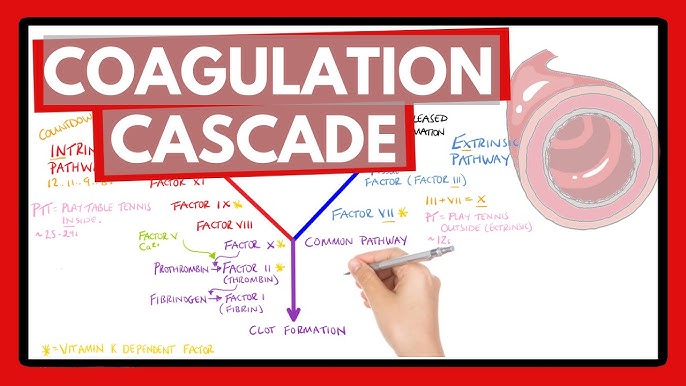The coagulation cascade is a critical biological process that prevents excessive bleeding in response to injury. It involves a series of complex steps where various proteins, known as coagulation factors, work together to form a blood clot. For healthcare professionals, especially students and those in the early stages of their careers, understanding this intricate sequence can seem daunting. However, learning the coagulation cascade through mnemonic devices can significantly simplify this process and provide a clear pathway for memorization and understanding.
What Is the Coagulation Cascade?
At its core, the coagulation cascade is a multi-step process that culminates in the formation of a stable blood clot. This is an essential mechanism for preventing excessive blood loss following an injury, whether external or internal. When damage occurs, the body must quickly mobilize various proteins in the blood to form a clot at the site of injury, stopping the bleeding.
The coagulation cascade is often divided into three main components:
- The intrinsic pathway, which is initiated by damage within the blood vessel.
- The extrinsic pathway, which is triggered by external trauma that exposes blood to tissue factor.
- The common pathway, where both the intrinsic and extrinsic pathways converge to complete the clotting process.
Although it seems complex at first glance, breaking down the cascade using mnemonic aids provides an effective method for learning and retaining this crucial information.
The Intrinsic Pathway: Breaking Down the Internal Process
The intrinsic pathway is initiated when damage occurs within the blood vessel, such as the exposure of collagen to blood plasma. This pathway is slower compared to the extrinsic pathway, but it plays an equally important role in ensuring that a clot forms in a controlled and sustained manner.
One of the challenges in learning this pathway is remembering the specific coagulation factors and their sequence of activation. A mnemonic that simplifies this is “TENET,” which stands for:
- T for Factor XII (12)
- E for Factor XI (11)
- N for Factor IX (9)
- E for Factor VIII (8)
- T for Factor X (10)
These coagulation factors are activated in a sequential manner, starting with Factor XII, which then activates Factor XI, followed by Factor IX, and so on, until Factor X is activated. Factor X is pivotal because it marks the point where the intrinsic and extrinsic pathways converge into the common pathway.
It’s important to note that calcium ions (Ca²⁺) and phospholipids are crucial for several steps in the intrinsic pathway, helping the coagulation factors adhere to cell surfaces and work efficiently. Without these key components, the process would slow down or stop entirely, leading to potential bleeding disorders.
The Extrinsic Pathway: A Faster Response
In contrast to the intrinsic pathway, the extrinsic pathway is activated when external trauma occurs, such as a cut or injury, that exposes blood to tissue factor (Factor III). This pathway is faster and acts as the body’s first line of defense in halting bleeding.
The primary players in this pathway are Factor VII and Tissue Factor (Factor III), which are activated almost immediately upon injury. A simple mnemonic to recall the key components of the extrinsic pathway is “Seven for Speed,” emphasizing the role of Factor VII as a rapid responder in clot formation.
- S for Factor VII (7)
- F for Tissue Factor (Factor III)
Upon exposure to tissue factor, Factor VII is activated and subsequently activates Factor X in the common pathway. This process happens swiftly, ensuring that the body can quickly seal off the injury site before excessive blood loss occurs.
The extrinsic pathway, though faster, is less complex than the intrinsic pathway, involving fewer steps and factors. However, it is just as important because it triggers the coagulation cascade’s initial response to trauma. Both the intrinsic and extrinsic pathways work in tandem to ensure the body maintains a balanced and effective clotting system.
The Common Pathway: Where Everything Comes Together
The final stage of the coagulation cascade is the common pathway, where both the intrinsic and extrinsic pathways converge. This is where the actual formation of the blood clot occurs, ensuring that the injury site is sealed and the bleeding stops.
To simplify the common pathway, a mnemonic to remember the key factors involved is “Five and Dime”:
- 5 for Factor V
- 10 for Factor X
Once Factor X is activated (from either the intrinsic or extrinsic pathway), it combines with Factor V to form a complex that converts prothrombin (Factor II) into thrombin. Thrombin is a critical enzyme in this process because it converts fibrinogen (Factor I) into fibrin, the protein that forms the stable mesh of the clot.
The fibrin strands then cross-link to create a firm and durable clot that effectively seals the injury site. This entire process is tightly regulated to prevent uncontrolled clotting or excessive bleeding, ensuring that the body maintains homeostasis.
Mnemonic Recap: A Quick Reference Guide
Learning the coagulation cascade can be made much easier with the use of mnemonics. Here’s a quick recap of the mnemonics covered:
- Intrinsic Pathway: TENET – XII (12), XI (11), IX (9), VIII (8), X (10)
- Extrinsic Pathway: Seven for Speed – VII (7), Tissue Factor (III)
- Common Pathway: Five and Dime – V (5), X (10)
These simple phrases provide an efficient way to recall the complex series of events in the coagulation cascade, helping healthcare professionals remember the sequence of factors and their roles in clot formation.
Why Is the Coagulation Cascade So Important?
Understanding the coagulation cascade is essential for diagnosing and treating various bleeding disorders. Deficiencies in any of the coagulation factors can lead to conditions such as Hemophilia A (Factor VIII deficiency) or Hemophilia B (Factor IX deficiency). Additionally, overactive clotting can result in dangerous conditions like deep vein thrombosis (DVT) or pulmonary embolism (PE).
In clinical practice, the coagulation cascade is also relevant in the management of patients with liver disease, as the liver produces many of the coagulation factors. Patients with liver dysfunction may have an increased risk of both bleeding and clotting complications, making it essential for healthcare providers to understand how the coagulation cascade functions.
Clinical Implications: More Than Just Clotting
The coagulation cascade does more than just prevent bleeding. It also plays a role in the immune system and inflammation. For example, thrombin, a key enzyme in the cascade, not only converts fibrinogen into fibrin but also activates various immune cells and stimulates the release of inflammatory mediators.
This connection between clotting and inflammation has important implications for conditions such as sepsis and autoimmune diseases. Research is ongoing to explore how targeting the coagulation cascade could lead to new treatments for these conditions, potentially improving outcomes for patients with inflammatory and immune disorders.
Practical Tips for Learning the Coagulation Cascade
Learning the coagulation cascade can be challenging, but with the right approach, it becomes much more manageable. Here are some tips to help you master this complex process:
-
Use Mnemonics: As discussed, mnemonics are an excellent way to simplify the learning process and make the information easier to recall.
-
Visual Aids: Diagrams and flowcharts can be incredibly helpful for visual learners. Try drawing the coagulation cascade on paper or using digital tools to create visual representations of each pathway.
-
Practice with Clinical Scenarios: Applying what you’ve learned in real-world situations helps solidify your understanding. Work through case studies or clinical scenarios where patients have coagulation disorders, and identify which part of the cascade is affected.
-
Regular Revision: Revisiting the material frequently is key to long-term retention. Set aside time each week to review the coagulation cascade and test your recall of the mnemonics.
Conclusion: Mastering the Coagulation Cascade
Understanding the coagulation cascade is a vital skill for anyone working in healthcare. The use of mnemonics such as TENET, Seven for Speed, and Five and Dime simplifies the learning process and ensures that even the most complex steps of the cascade are easy to remember.
By combining mnemonics with visual aids and clinical application, healthcare professionals can confidently navigate the intricacies of the coagulation cascade. Mastery of this process not only improves diagnostic accuracy but also enhances the ability to manage patients with bleeding and clotting disorders effectively.
Incorporating these tools into your learning strategy will equip you with the knowledge necessary to provide the best possible care to your patients, whether in a trauma setting, during surgery, or in the management of chronic conditions. For more updates visit our website: Reporterun.com



